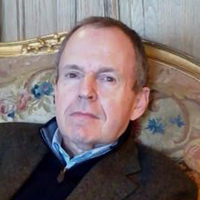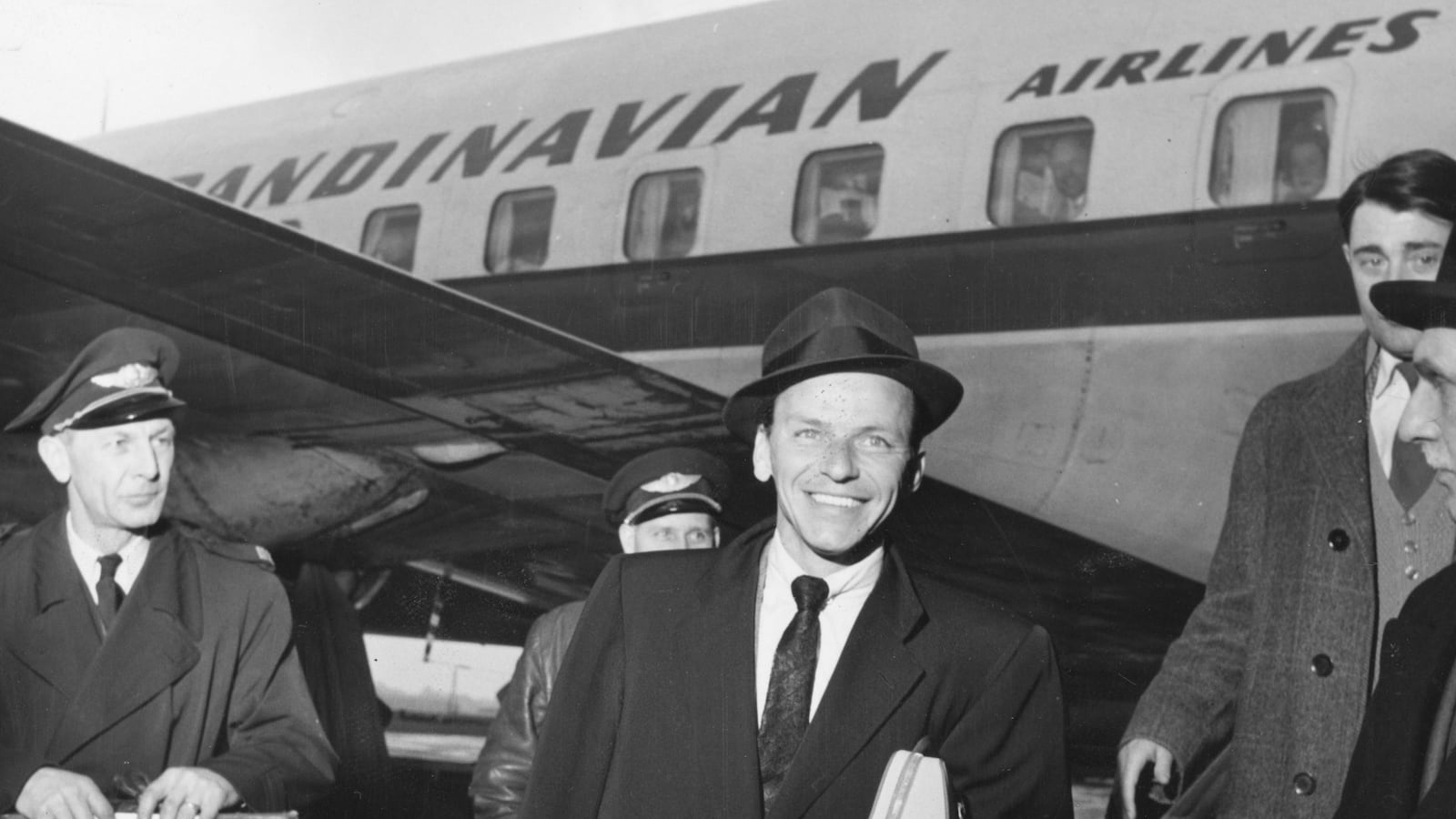The poster boy for the Jet Set had a big secret. Frank Sinatra was afraid of flying. His 1958 album Come Fly with Me had become the soundtrack for the new jet age that had kicked off that same year in October with Pan Am’s 707 service between New York and Paris. Yet Sinatra wouldn’t be caught dead on Pan Am or TWA or even Air France, no matter how good the meals, catered by La Tour d’Argent, were supposed to be. “Dead” was the operative word for Sinatra, that most distrustful of all superstars. He simply didn’t believe the airlines were careful enough. That was why he had his own plane, a big dual-prop Martin 404 called, in those days before political correctness, El Dago. Before the advent of the jets, the Martin was state-of-the art, air-conditioned, pressurized, and customized for his hard-drinking Rat Pack show-business buddies, with a piano and a central bar almost as long as the one at Chasen’s. Hollywood felt at home here in the air, though for the nervous Sinatra, the El Dago bar was a necessity rather than a status symbol.
Aside from insisting on war-hero private pilots, Sinatra obsessively had his valet, ex—navy man George Jacobs, spend even more time checking weather reports and communicating with all the airports on their prospective routes to make sure there would be no nasty surprises than Jacobs did in arranging starlet assignations for his master. Sinatra once threw a fit when Jacobs arranged a post-dinner screening of the classic airline near-disaster film, The High and the Mighty, notwithstanding John Wayne’s saving the day—and the plane. And he confided in Jacobs that he had a recurring nightmare inspired by The Glenn Miller Story, wherein the big bandleader disappeared over the foggy Channel on a flight from England to Paris. Moreover, Sinatra was still haunted by having bailed out, at the last second, of a 1958 cross-country flight with Around the World in 80 Days impresario and Elizabeth Taylor husband Mike Todd on his plane The Lucky Liz, which went down in a fireball in a New Mexico cornfield.
Such high anxiety was not the stuff of American legends, especially that of the swaggering, carefree, ring-a-ding variety that Sinatra apotheosized. He knew he had to get with the program, the jet program. After all, he was supposed to be the program. Accordingly, in 1962, when the ocean liners were still carrying more passengers across the Atlantic than the new jets, Sinatra did more than anyone thus far to emblazon the jet fantasy in the still-sedentary imagination of America. His high-profile grand gesture was chartering his own 707 for a three-month round-the-world tour to benefit children’s charities in the countries he would visit. He would fly from L.A. to Tokyo, to Hong Kong, then across the globe to Israel, Greece, Italy, France, England, a swinging, speedy update of the grand tour for the Sputnik era.
What the world didn’t realize was that, for all his ostensible altruism, Sinatra’s charity began at home. The new commercial jets may have needed passengers, but Sinatra needed something, too: a makeover of a Mafia image occasioned by his guilt-by-association relationship with Chicago Mob boss Sam Giancana. While Giancana may have been instrumental in stealing Illinois, and the presidency, for John F. Kennedy in 1960, it was a debt that Attorney General Bobby Kennedy was intent on wiping from the ledger, even if that meant obliterating the playboy friendship between Sinatra and his brother. Bobby was so down on Sinatra, who had reconstructed his Palm Springs compound to become JFK’s own Western White House, that he pressured his brother into rejecting the Sinatra hospitality and bunking instead at chez Bing Crosby, Sinatra’s archrival and an even archer Republican.
Humiliated, Sinatra, at the advice of his master-strategist lawyer, Mickey Rudin, decided to get out of Dodge—all the way out to Tokyo, as far as a 707 would take him. His entourage wasn’t comprised of the usual Jet Set suspects, ultramobile international legends like Onassis, Agnelli, Rubirosa, or even Jacqueline Kennedy herself, whose high-profile Francophilia was proving to be a greater gesture of Franco-American comity than the Statue of Liberty. No, instead of the global nomads, Sinatra filled his 707 with his regiment of musicians and his best local buddies. The latter included his favorite Beverly Hills restaurateur, “Prince” Mike Romanoff, everyone’s favorite charlatan, on whom Sinatra counted to get him the best tables on earth; his personal banker, Al Hart, head of Beverly Hills’s City National and the man who financed Sinatra’s comeback film, From Here to Eternity, to pay the freight; his songwriter and sexmeister Jimmy Van Heusen, himself an accomplished pilot, to get the girls; and legendary New York Giants baseball manager Leo “The Lip” Durocher, to provide all-American ballpark ballast amid the anticipated dislocations and alienations of the long foreign journey.
While not exactly the Ugly American, Sinatra provided plenty of his own homegrown ballast. For all his previous international performances and global exposure, Sinatra had almost no interest in foreign cultures, except for the women. He couldn’t have cared less about the Louvre or Versailles, classic architecture, or haute cuisine. In fact, he had George Jacobs stock the 707 with a three-month supply of his favorite snack, Campbell’s franks and beans, which he would devour cold, straight from the tin. This was soul food, Hoboken-style. God forbid Sinatra would have to ingest sushi or chop suey or foie gras or, even on his ostensible home turf, spaghetti alla vongole. Even in Italy, the star invariably rejected the alta cucina grand-hotel fare of Rome’s Excelsior and Milan’s Principe di Savoia. Instead, he insisted that Jacobs, an accomplished navy cook whom Sinatra’s mother Dolly had taught to “do” bridge-and-tunnel red-gravy transplant-paisan food, prepare his Jersey favorites in the kitchen of his suite.
Sinatra left for Tokyo in April 1962, perfect for cherry-blossom time. His tour instantly generated massive worldwide news coverage, just as lawyer Rudin had promised. Every day the still-powerful syndicated gossip columns, led by Hearst’s “Cholly Knickerbocker,” the nom de plume of the worldly and genuine Russian count Igor Cassini, featured breathlessly glamorous dispatches on Sinatra’s mix of good deeds and high life, visiting a Buddhist monastery on Mount Fuji, endowing a youth center on the Sea of Galilee, cruising the Mediterranean on Onassian yachts, serenading his High Society costar Princess Grace at a series of “Chinchilla and Diamonds” concert benefits at the Sporting Club in Monte Carlo designed to soak high rollers for the benefit of poor kids.
Sinatra had El Dago flown over to Europe to replace the 707 for short intercontinental hops, though in a nod to his quest to sanitize his escutcheon, it had been renamed the Christina, after his younger daughter. He posed with blind children in Greece and crippled children in Italy and orphans in England. He sang everywhere, from the Mikado Theater in Tokyo, to the Parthenon in Athens, to the Baths of Caracalla in Rome, to the Royal Festival Hall in London. He was feted by everyone from the emperor of Japan to Princess Grace to Princess Margaret (whom he tried, unsuccessfully, to bed) to General de Gaulle, who got over being not invited by Prince Rainier to the Monaco gala and decorated Sinatra as a chevalier of the Order of Public Health, an ironic honor given the unsalubrious post-concert orgies being carried on in the entertainer’s imperial suite at the Hotel George V. The fantasy trip of a lifetime, Sinatra’s “one man, one world” extravaganza underscored, as nothing before it, the jet-age miracle of making the planet seem, if not small, then certainly accessible.
In 1964, Sinatra signed a contract with the Learjet Corporation to buy one of their first-generation private jets. Lear congratulated Sinatra on purchasing “the world’s finest business machine.” By 1964 Sinatra, nearing fifty, was chairman of Reprise, his own record label; he also oversaw his film company, his huge real estate holdings, and a major investment in a missile parts manufacturer. Sinatra was now a Big Businessman, and a Learjet, the ultimate corporate tool, was as natural a component of his portfolio as his cellar full of Jack Daniel’s. He tastefully named the Lear the Christina II. The Hoboken swagger had been replaced by a Wall Street stride.
Not that the Rat Pack party days were completely behind him. He used the Lear—which seated only six and had no bar—mostly to shuttle his pals between Los Angeles, Palm Springs, and Las Vegas. For the long hauls and the concert tours, he still chartered the big 707s. But he loved showing off the Lear as the party favor for a Hollywood that had everything. He flew a wide-eyed Mia Farrow on it to Palm Springs for their first date, and to the Côte d’Azur for their 1966 honeymoon. He snowed Michael Caine, when Caine was dating Sinatra’s daughter Nancy, by Learing him to Vegas, just the two guys, heart-to-heart, to make sure Caine’s intentions were honorable. Sinatra assumed that the truth would be spoken at 30,000 feet. Sinatra lent the Lear to Sammy Davis, Jr., and Marlon Brando to fly to Mississippi to join Martin Luther King, Jr., on a freedom march. He lent it to Elvis Presley, whom he once despised as vulgar but came to embrace, for the King and Priscilla Beaulieu to fly from Palm Springs to Las Vegas to get hitched by a justice of the peace. He lent it to the Beatles. And in 1967, having been instrumental in making the Learjet the millionaire’s favorite status symbol, he sold it, trading up to the new Gulfstream GII, which did have room for a bar, though not as big as El Dago’s. By now the chairman was drinking less. In 1972, he bought his very own 707, one originally built for Australia’s Qantas.
In January 1977, the ultimate irony befell Sinatra. He was about to fly his entourage on his current jet from Palm Springs to his opening night at Caesar’s Palace. But his beloved mother, Dolly, visiting from New Jersey, couldn’t stand Sinatra’s new wife, Barbara Marx, and refused to fly with her. So Sinatra simply chartered Dolly her own Learjet for the twenty-minute flight to Las Vegas. The plane was overflowing with a cornucopia of luxury food and amenities, as if destined for Paris.

It was one of those rare winter days when it was cloudy in Palm Springs. The pilot, who had flown the short route countless times, was undeterred. But, this pilot was in error. The clouds became a blinding blizzard, and the Lear crashed into the massive Mount San Gorgonio, instantly killing Dolly, her friend, and the Lear’s crew.
The pallbearers at Dolly Sinatra’s funeral included Frank’s old flying buddies Jimmy Van Heusen, Leo Durocher, and Dean Martin. Frank was so traumatized by the loss that he reembraced his long-lost Catholicism and forced his wife, Barbara, to convert. But no religion could restore his shaken faith in private jet aviation, or his faith in himself as always being in control, that his way was the safe way. He could never believe that the anxieties he’d fought so hard could come true, that a Sinatra could die in a plane crash. “She was a woman who flew maybe five times a year,” he mumbled incredulously to the press. “I could understand if it happened to me …”
From JET SET by William Stadiem. Reprinted by arrangement with Ballantine Books, an imprint of Random House, a division of Random House LLC. Copyright © 2014 by William Stadiem.






